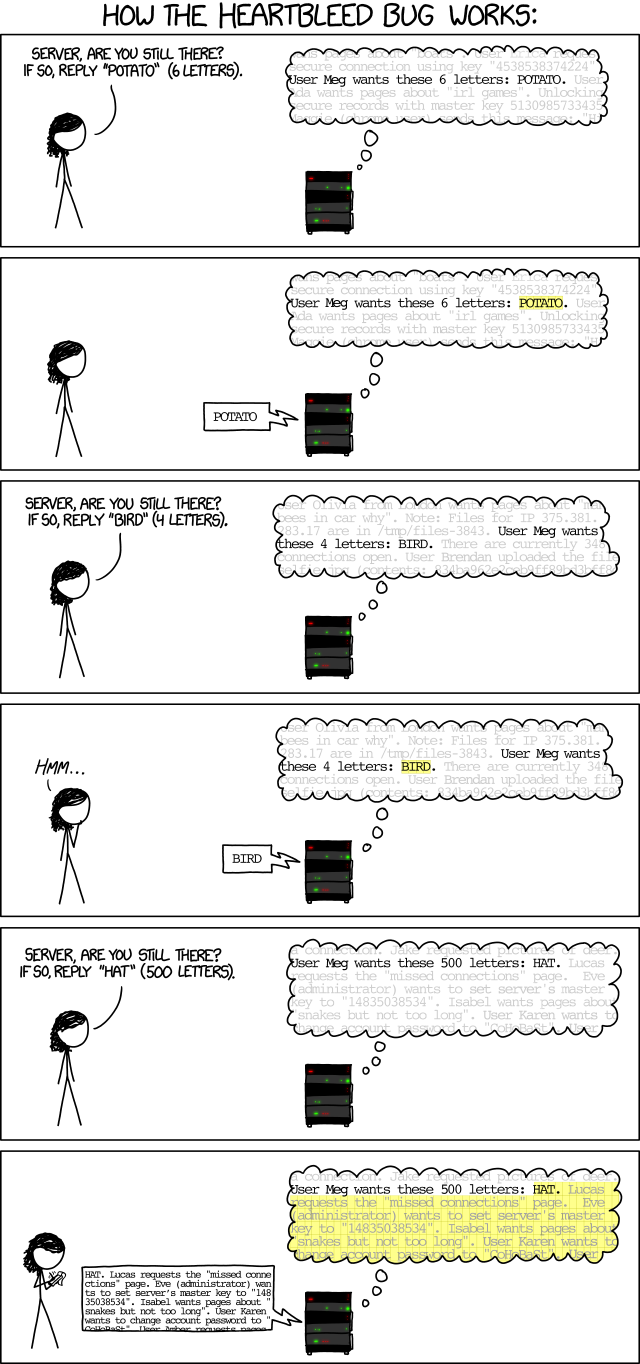The heartbleed bug

I am sure you have all heard about the "Heartbleed" bug affecting OpenSSL recently, and many people around me ask me about this bug, so I decided to make an article so that everyone can understand how it works. It is actually quite simple to understand, so even if you don't read the technical details you should be able to understand.
Non-technical explanation
First, OpenSSL is an open-source software which aims to implement the TLS protocol (formerly called the SSL protocol). The TLS protocol was created to provide an efficient way to establish a secure connection between two points so that no one can normally know what those two point are "talking" about together. If you go to your bank website, the URL should be something like "https://" (if not, consider changing bank :D) that means you are communicating safely with your bank over the TLS protocol.
The problem is that every time you make a request to the server (when you go to another page for example) you have to re-establish a secure connection, and it takes time. Developers then decided to create a "keep-alive" system, allowing the user to regularly specify to the server that it is still here, so the server won't close the secure connection, and it won't have to be re-created after. This "keep-alive" system has been called "Heartbeat".
Let's see how heartbeat works:
- The client sends a message (a packet) to the server. This packet stands for "I'm still alive, do not close the connection". This message contains two important info: a randomly generated string and its size.
- The server receives this packet and stores it in memory for a few time (a few ms) so he can finish what he was doing. Once finished, he looks in his memory to find the sent message, and reads it to send it back to the client. He knows when he finished reading, because the client sent him the size of the message.
- The client receives the message he sent to the server a few ms ago, everything is working fine, the connection is kept alive.
Do you see the flaw here? There's no server-side control to check if the sent message is actually the same size as the sent size. So if the user specify a greater size than the message's size, the server will work the same way, and it will return some of its memory's content located after the message! And it is a huge problem, because in this memory there can be passwords, private data, files etc.
Here's a little comic from xkcd.

On the technical side
Here's what the Heartbleed bug looks in the code[^2]
unsigned char *p = &s->s3->rrec.data[0], *pl;
unsigned short hbtype;
unsigned int payload;
hbtype = *p++;
n2s(p, payload);
pl = p;
Here, p points to the received data, hbtype represents the type of the message
(either request or response), payload is the size of the payload
(the message contained in the received packet).
The line 5 reads the first byte of the packet (the type of the message), makes p point
on the next byte, and sets hbtype to the type of message.
The line 6 reads the next two bytes^1, copies
them to the payload variable and makes the pointer point two bytes further.
pl is a pointer to the payload.
Here is how the server replies:
unsigned char *buffer, *bp;
unsigned int write_length = 1 +
2 +
payload +
padding;
buffer = OPENSSL_malloc(write_length);
bp = buffer;
*bp++ = TLS1_HB_RESPONSE;
s2n(payload, bp);
memcpy(bp, pl, payload);
Here, the length of the response is computed like :
- 1 byte to store the type of the message (request or response)
- 2 bytes to store the length of the payload
payloadbytes to store the payloadpaddingbytes so the message has a fixed length
Line 7 allocates the memory needed for the response, line 8 makes bp point to
this memory area.
Line 9 writes the type to the response, and makes bp point to the next byte.
Line 10 writes the size of the payload (two bytes) to the response, and shift the pointer by two bytes, so it now points on the message.
Line 11 copies the sent message to the response on payload bytes. Here is the flaw.
The size was never checked on the server-side, so we rely on the size sent by
the client to read from the server's memory.
Therefore, it is really easy to get interesting data from the server, you just have to specify the maximum length for the message (0xFFFF), and to write an empty or a really short message, and the response will contain the next 64kB after the message in the server's memory (possibly credentials, files, ...)
Conclusion
Here are some lessons we can learn from the Heartbleed bug:
- be really careful when treating sensible data with low-level languages where you have to manually handle the memory.
- use proper name for variables, do not hesitate to write lengthy comments, this way other developers can quickly understand what the code is doing, and reveal issues before they are being exploited.
- do not skip the testing phase. I am sorry to say that, but This bug could have been easily discovered by sending random values to the server and by comparing to the response to the request.
Notes
[^1]: here you can see that, fortunately, the size is encoded on two bytes, so the size can be up to $$ 2^{16} = 65536$$ bytes, ~64kB). Thus the leak cannot be bigger than 64kB. That is why you should carefully choose your data types before writing code. Imagine how worse the bug would have been is the size was encoded on 4 bytes (~4MB) [^2]: the code can be found on Github